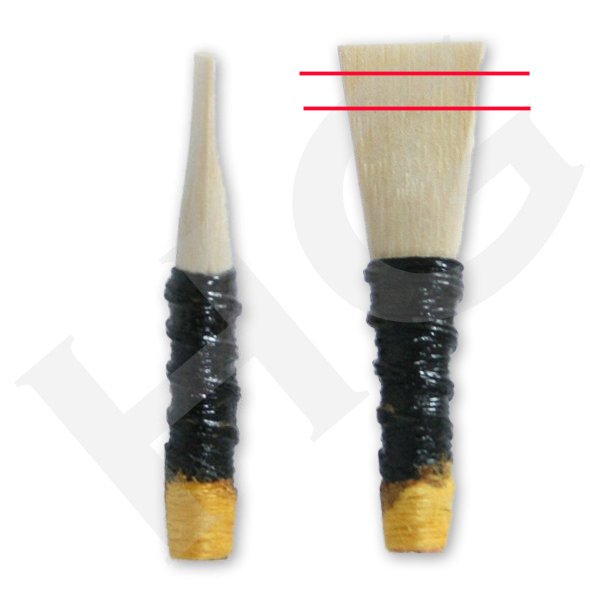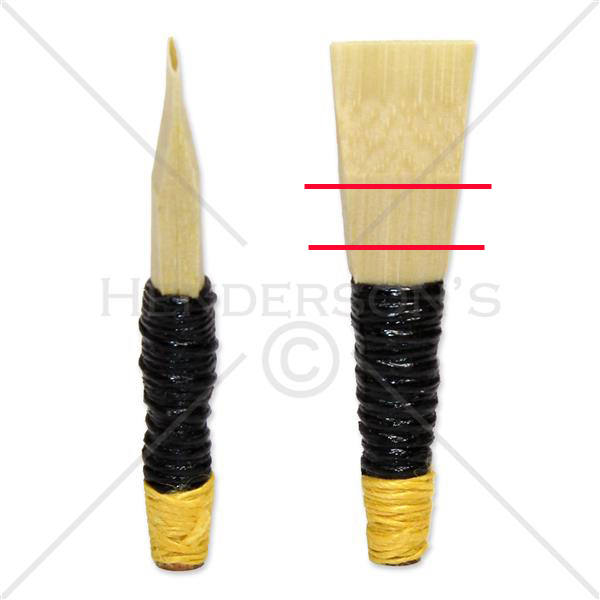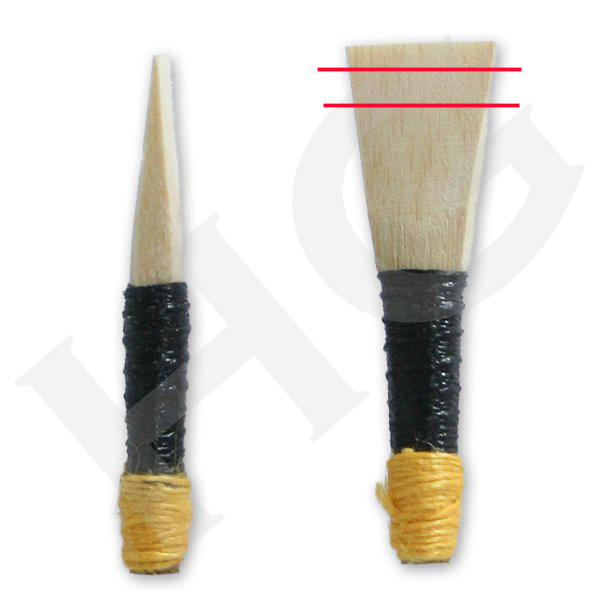The bagpipe chanter reed is perhaps the single largest source of frustration for a piper. New reeds are usually difficult to blow and can make blowing your bagpipe a physically and emotionally draining experience. All reeds weaken after an initial "blowing in" period. Some pipers, however, try to avoid the process by selecting weaker reeds or hasten the process by performing "rites of passage" on the reed.
Selecting and adjusting your chanter reed
It is very unusual for a reed to come "ready to play." There is a "breaking-in" period that may be a few days or a few weeks, depending on the initial strength and depending on what the piper is striving for as a finished product. It is likely that the Pipe Major will exert some influence in the selection of reeds and breaking-in methods. Here are some tips that you may find useful:
1. Avoid choosing reeds that are easy to blow. Generally speaking, all reeds will weaken after an initial blowing-in period. A stronger reed will usually deliver a better sound, and will hold up better under lengthy or frequent blowing. A reed is stronger (harder to blow) for only a few reasons and can usually be made manageable without negatively affecting the sound. Weak reeds usually deliver an inferior sound, and there is not much that can be done to correct this.
2. Choose reeds that are responsive and vibrate freely when blown directly through the lips or in a pipe chanter. You may even detect a "craw," which is indicative of a well made reed that will probably be a top performer.
3. Look for well-made reeds. The blades should look identical and should join perfectly at the sides. There should be no separation at all along either side of the reed. The blades should be mirror images of one another. Grasp the reed by the blades and press together lightly. The “give” should be equal. Reject those reeds where one side is weaker than the other. Also make sure the tips are cut cleanly and evenly across. Reject any reed where one blade is longer than the other.
Each reed is divided into three areas, the tips, the middle, and the sound box.
The sound box supports the rest of the reed and contributes greatly to bottom hand sound and strength. It should not be scraped or sanded. To lessen the strength of a reed by working with the sound box, grasp the reed at the top of the sound box and squeeze gently until you can feel some "give" in the cane. If you squeeze too low and collapse the sound box, the reed is garbage.
The tips of the reed are very delicate and should not be scraped or sanded. It is possible to clean any foreign growth with a sharp blade, but care should be taken not to disturb the cane. Sometimes a reed will develop a pronounced coarseness on the High A or High G. Sometimes this can be corrected by gently sanding the tips of the reed. This job is best left to experienced pipers.
The middle of the reed can be addressed with a degree of predictability. Scraping the middle section will generally weaken the reed allowing it to vibrate more freely. It will also flatten the top hand notes slightly. Always work with the grain, never against the grain.
It is best to make small modifications only, and to blow the reed for at least ten minutes before pursuing further adjustment. You will find that it is easy to remove material and very difficult to return it. To learn these techniques and others, it is best to seek out a piper who is experienced in these matters. There are some great videos on YouTube for adjusting your chanter reed.
Breaking in your chanter reed
For many years now, pipers have been coming to me for chanter reeds. Over the years, I suppied many of my bandmates with reeds that were basically ready to play. My secret is simple. I break my reeds in "outside" of the bagpipe.
As I said earlier, the reeds of choice generally start out very difficult. You have no doubt heard them referred to as "gut-busters." From my perspective, these reeds are the very best, however impossible to blow in a bagpipe until properly blown in. I usually start out with a batch of about half a dozen reeds or so. Every day, for about one week, I go through my reed-bottle and play each of the reeds for just a minute. I go up and down the scale once or twice, put a bit of warm, moist air through them, and immediately return them to the bottle. During the week, the reed's "personality" will start to emerge.
During this period, the reed starts to undergo changes. Small hair-like cane fibers will stand up on the reed. The pitch will steadily start to increase. The cane itself will begin to harden further. Sometimes, all that is required is to blow the reed until it is free. Other times, a reed will require a pinch, or a scrape, or a touch of moisture to bring it to where it needs to be. Without attempting to cover off all the possibilities, a general rule of thumb is to be as conservative as you can be in order to achieve the desired results.
As a general rule, during the break-in period, do not
1. wet the reed
2. pinch the reed
3. scrape the reed
4. dry the reed out
5. expect it to be perfect
Once the reed starts to find itself, it can be coaxed towards where you want it to be. This may involve scraping the reed. This will tend to flatten off the top hand, free up the reed and make it easier to blow and it will produce more sound. Be very conservative. There is a point of diminishing returns.
It may also involve pinching the reed. I am not a strong proponent of pinching as it weakens the reed and causes the pitch to sharpen. However I do recognize that a pinch may be necessary to sharpen the top hand. This will also help to eliminate those double-toning “F’s” that come out of nowhere. When “pinching down” a reed, be very conservative. You don’t want to collapse the reed or permanently damage the blades.
Once the reed is “free” and somewhat more comfortable to blow, I carefully inspect the reed for "growth" on the blades. This isn't actually growth, but rather tiny cane hairs that are standing up on the surface of the blade. Using a sharp, straight knife or razor blade at 90 degrees to the reed blade, I scrape this growth away. VERY IMPORTANT that you only scrape the top portion of the reed, about 1/4 inch from the tips to about 1/16 inch of the tips. Do not scrape below that area or above that area. Do not cut. Scrape the reed!
In some instances, a reed can be broken in, using this technique, in about three or four weeks. Other times, it takes a couple of months. The important thing is to not rush the reed during this breaking in period. Through experience, and applying tricks you learn along the way, you can consistently achieve a high rate of success and produce competition quality reeds.
I will also state here that if properly cared for, a good chanter reed should last several months if not longer. I know one piper who played his reed for three seasons and three world championships. I know that reed makers will hate me for saying this, however if you're replacing your reed after only a couple of months, you're doing something wrong.
I personally start out with a new reed each January. By March it is exactly where I want it to be, in terms of pitch, strength, and volume. By the end of the competition season, it has lost just a bit of strength however is still very dependable. Although tempted, I usually retire the reed by January or farm it out to someone in need.
Be careful about exposing reeds to dry, heated air. Keep them locked up in a pill bottle or in your bagpipe, or in a reed protector to retain their integrity. Five minutes in the dry air and they'll turn into scrap. Reeds dislike sudden changes in their moisture content. If you wet the reed excessively, it will become dull and lifeless. If you dry it to quickly, the blades will collapse and the reed is ruined.
Where you store your bagpipes and reeds has a great influence on how long they last and how they sound and behave. I move my pipes around throughout the year. I'm careful not to shock them with sudden radical changes. In the wintertime, I keep my pipes in a closet, away from dry heat, but not in a cold place. In the summertime, I store my pipes where there's good air circulation, away from any affects of air conditioning.
The best way of keeping your reeds and your pipes in top playing condition is to visit them often and to listen to them. They will always tell you what they need. It may be just a bit of moisture or conversly perhaps a bit of air.
Despite your best care and precautions, accidents do happen. Always carry a backup reed that will do in a pinch. Visit it often to ensure that it keeps well. Remember, you won't need one until you really need one.
Selecting and adjusting your chanter reed
It is very unusual for a reed to come "ready to play." There is a "breaking-in" period that may be a few days or a few weeks, depending on the initial strength and depending on what the piper is striving for as a finished product. It is likely that the Pipe Major will exert some influence in the selection of reeds and breaking-in methods. Here are some tips that you may find useful:
1. Avoid choosing reeds that are easy to blow. Generally speaking, all reeds will weaken after an initial blowing-in period. A stronger reed will usually deliver a better sound, and will hold up better under lengthy or frequent blowing. A reed is stronger (harder to blow) for only a few reasons and can usually be made manageable without negatively affecting the sound. Weak reeds usually deliver an inferior sound, and there is not much that can be done to correct this.
2. Choose reeds that are responsive and vibrate freely when blown directly through the lips or in a pipe chanter. You may even detect a "craw," which is indicative of a well made reed that will probably be a top performer.
3. Look for well-made reeds. The blades should look identical and should join perfectly at the sides. There should be no separation at all along either side of the reed. The blades should be mirror images of one another. Grasp the reed by the blades and press together lightly. The “give” should be equal. Reject those reeds where one side is weaker than the other. Also make sure the tips are cut cleanly and evenly across. Reject any reed where one blade is longer than the other.
Each reed is divided into three areas, the tips, the middle, and the sound box.
The sound box supports the rest of the reed and contributes greatly to bottom hand sound and strength. It should not be scraped or sanded. To lessen the strength of a reed by working with the sound box, grasp the reed at the top of the sound box and squeeze gently until you can feel some "give" in the cane. If you squeeze too low and collapse the sound box, the reed is garbage.
The tips of the reed are very delicate and should not be scraped or sanded. It is possible to clean any foreign growth with a sharp blade, but care should be taken not to disturb the cane. Sometimes a reed will develop a pronounced coarseness on the High A or High G. Sometimes this can be corrected by gently sanding the tips of the reed. This job is best left to experienced pipers.
The middle of the reed can be addressed with a degree of predictability. Scraping the middle section will generally weaken the reed allowing it to vibrate more freely. It will also flatten the top hand notes slightly. Always work with the grain, never against the grain.
It is best to make small modifications only, and to blow the reed for at least ten minutes before pursuing further adjustment. You will find that it is easy to remove material and very difficult to return it. To learn these techniques and others, it is best to seek out a piper who is experienced in these matters. There are some great videos on YouTube for adjusting your chanter reed.
Breaking in your chanter reed
For many years now, pipers have been coming to me for chanter reeds. Over the years, I suppied many of my bandmates with reeds that were basically ready to play. My secret is simple. I break my reeds in "outside" of the bagpipe.
As I said earlier, the reeds of choice generally start out very difficult. You have no doubt heard them referred to as "gut-busters." From my perspective, these reeds are the very best, however impossible to blow in a bagpipe until properly blown in. I usually start out with a batch of about half a dozen reeds or so. Every day, for about one week, I go through my reed-bottle and play each of the reeds for just a minute. I go up and down the scale once or twice, put a bit of warm, moist air through them, and immediately return them to the bottle. During the week, the reed's "personality" will start to emerge.
During this period, the reed starts to undergo changes. Small hair-like cane fibers will stand up on the reed. The pitch will steadily start to increase. The cane itself will begin to harden further. Sometimes, all that is required is to blow the reed until it is free. Other times, a reed will require a pinch, or a scrape, or a touch of moisture to bring it to where it needs to be. Without attempting to cover off all the possibilities, a general rule of thumb is to be as conservative as you can be in order to achieve the desired results.
As a general rule, during the break-in period, do not
1. wet the reed
2. pinch the reed
3. scrape the reed
4. dry the reed out
5. expect it to be perfect
Once the reed starts to find itself, it can be coaxed towards where you want it to be. This may involve scraping the reed. This will tend to flatten off the top hand, free up the reed and make it easier to blow and it will produce more sound. Be very conservative. There is a point of diminishing returns.
It may also involve pinching the reed. I am not a strong proponent of pinching as it weakens the reed and causes the pitch to sharpen. However I do recognize that a pinch may be necessary to sharpen the top hand. This will also help to eliminate those double-toning “F’s” that come out of nowhere. When “pinching down” a reed, be very conservative. You don’t want to collapse the reed or permanently damage the blades.
Once the reed is “free” and somewhat more comfortable to blow, I carefully inspect the reed for "growth" on the blades. This isn't actually growth, but rather tiny cane hairs that are standing up on the surface of the blade. Using a sharp, straight knife or razor blade at 90 degrees to the reed blade, I scrape this growth away. VERY IMPORTANT that you only scrape the top portion of the reed, about 1/4 inch from the tips to about 1/16 inch of the tips. Do not scrape below that area or above that area. Do not cut. Scrape the reed!
In some instances, a reed can be broken in, using this technique, in about three or four weeks. Other times, it takes a couple of months. The important thing is to not rush the reed during this breaking in period. Through experience, and applying tricks you learn along the way, you can consistently achieve a high rate of success and produce competition quality reeds.
I will also state here that if properly cared for, a good chanter reed should last several months if not longer. I know one piper who played his reed for three seasons and three world championships. I know that reed makers will hate me for saying this, however if you're replacing your reed after only a couple of months, you're doing something wrong.
I personally start out with a new reed each January. By March it is exactly where I want it to be, in terms of pitch, strength, and volume. By the end of the competition season, it has lost just a bit of strength however is still very dependable. Although tempted, I usually retire the reed by January or farm it out to someone in need.
Be careful about exposing reeds to dry, heated air. Keep them locked up in a pill bottle or in your bagpipe, or in a reed protector to retain their integrity. Five minutes in the dry air and they'll turn into scrap. Reeds dislike sudden changes in their moisture content. If you wet the reed excessively, it will become dull and lifeless. If you dry it to quickly, the blades will collapse and the reed is ruined.
Where you store your bagpipes and reeds has a great influence on how long they last and how they sound and behave. I move my pipes around throughout the year. I'm careful not to shock them with sudden radical changes. In the wintertime, I keep my pipes in a closet, away from dry heat, but not in a cold place. In the summertime, I store my pipes where there's good air circulation, away from any affects of air conditioning.
The best way of keeping your reeds and your pipes in top playing condition is to visit them often and to listen to them. They will always tell you what they need. It may be just a bit of moisture or conversly perhaps a bit of air.
Despite your best care and precautions, accidents do happen. Always carry a backup reed that will do in a pinch. Visit it often to ensure that it keeps well. Remember, you won't need one until you really need one.
Molded Reed
Ridgecut Reed
Straight-sided Reed
How to Select / Adjust a Chanter Reed




